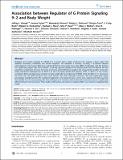| dc.contributor.author | Waugh, Jeffrey L. | |
| dc.contributor.author | Celver, Jeremy | |
| dc.contributor.author | Sharma, Meenakshi | |
| dc.contributor.author | Dufresne, Robert L. | |
| dc.contributor.author | Terzi, Dimitra | |
| dc.contributor.author | Risch, S. Craig | |
| dc.contributor.author | Fairbrother, William G. | |
| dc.contributor.author | Neve, Rachael L. | |
| dc.contributor.author | Kane, John P. | |
| dc.contributor.author | Malloy, Mary J. | |
| dc.contributor.author | Pullinger, Clive R. | |
| dc.contributor.author | Gu, Harvest F. | |
| dc.contributor.author | Tsatsanis, Christos | |
| dc.contributor.author | Hamilton, Steven P. | |
| dc.contributor.author | Gold, Stephen J. | |
| dc.contributor.author | Zachariou, Venetia | |
| dc.contributor.author | Kovoor, Abraham | |
| dc.date.accessioned | 2012-02-23T19:12:42Z | |
| dc.date.available | 2012-02-23T19:12:42Z | |
| dc.date.issued | 2011-11 | |
| dc.date.submitted | 2011-09 | |
| dc.identifier.issn | 1932-6203 | |
| dc.identifier.uri | http://hdl.handle.net/1721.1/69174 | |
| dc.description.abstract | Regulator of G protein signaling 9–2 (RGS9–2) is a protein that is highly enriched in the striatum, a brain region that mediates motivation, movement and reward responses. We identified a naturally occurring 5 nucleotide deletion polymorphism in the human RGS9 gene and found that the mean body mass index (BMI) of individuals with the deletion was significantly higher than those without. A splicing reporter minigene assay demonstrated that the deletion had the potential to significantly decrease the levels of correctly spliced RGS9 gene product. We measured the weights of rats after virally transduced overexpression of RGS9–2 or the structurally related RGS proteins, RGS7, or RGS11, in the nucleus accumbens (NAc) and observed a reduction in body weight after overexpression of RGS9–2 but not RGS7 or 11. Conversely, we found that the RGS9 knockout mice were heavier than their wild-type littermates and had significantly higher percentages of abdominal fat. The constituent adipocytes were found to have a mean cross-sectional area that was more than double that of corresponding cells from wild-type mice. However, food intake and locomotion were not significantly different between the two strains. These studies with humans, rats and mice implicate RGS9–2 as a factor in regulating body weight. | en_US |
| dc.description.sponsorship | National Institute of Mental Health (U.S.) (R41MH78570 award) | en_US |
| dc.description.sponsorship | National Center for Research Resources (U.S.) (Rhode Island IDeA Network of Biomedical Research Excellence (RI-INBRE) Award P20RR016457-10) | en_US |
| dc.language.iso | en_US | |
| dc.publisher | Public Library of Science | en_US |
| dc.relation.isversionof | http://dx.doi.org/10.1371/journal.pone.0027984 | en_US |
| dc.rights | Creative Commons Attribution | en_US |
| dc.rights.uri | http://creativecommons.org/licenses/by/2.5/ | en_US |
| dc.source | PLoS | en_US |
| dc.title | Association between Regulator of G Protein Signaling 9–2 and Body Weight | en_US |
| dc.type | Article | en_US |
| dc.identifier.citation | Waugh, Jeffrey L. et al. “Association Between Regulator of G Protein Signaling 9–2 and Body Weight.” Ed. Malú G. Tansey. PLoS ONE 6.11 (2011): e27984. Web. 23 Feb. 2012. | en_US |
| dc.contributor.department | Massachusetts Institute of Technology. Department of Brain and Cognitive Sciences | en_US |
| dc.contributor.approver | Neve, Rachael L. | |
| dc.contributor.mitauthor | Neve, Rachael L. | |
| dc.relation.journal | PLoS ONE | en_US |
| dc.eprint.version | Final published version | en_US |
| dc.type.uri | http://purl.org/eprint/type/JournalArticle | en_US |
| eprint.status | http://purl.org/eprint/status/PeerReviewed | en_US |
| dspace.orderedauthors | Waugh, Jeffrey L.; Celver, Jeremy; Sharma, Meenakshi; Dufresne, Robert L.; Terzi, Dimitra; Risch, S. Craig; Fairbrother, William G.; Neve, Rachael L.; Kane, John P.; Malloy, Mary J.; Pullinger, Clive R.; Gu, Harvest F.; Tsatsanis, Christos; Hamilton, Steven P.; Gold, Stephen J.; Zachariou, Venetia; Kovoor, Abraham | en |
| dc.identifier.orcid | https://orcid.org/0000-0002-3854-5968 | |
| mit.license | PUBLISHER_CC | en_US |
| mit.metadata.status | Complete | |
